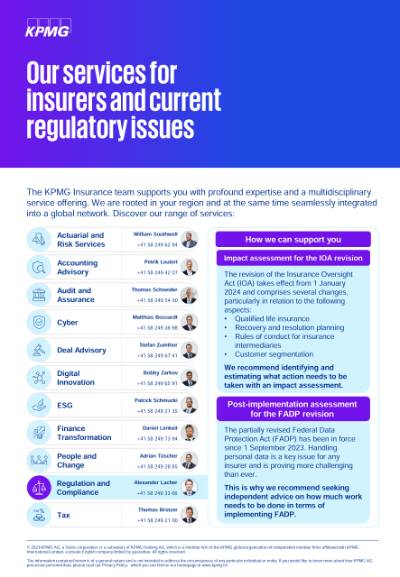The continuing uncertain economic climate has brought business unprecedented levels of change and has forced insurers to look closely at the way they run their business.
Insurers are focusing on the future to decide how to change their business and operating models to remain competitive while maintaining compliance with a changing regulatory landscape.
With a focus on automation, data science tools and techniques, we help clients to prepare for the future.
How we can support you
We have 460 insurance actuaries in 21 countries across Europe, and global actuarial resources of over 700. Our Swiss team of 25 actuaries brings deep practical experience and provides a full range of skills, helping insurers across a number of areas:
- Risk and Capital Management: Enhancing the understanding of risk and capital and how they can be best managed to meet current and future business needs. Own Risk and Solvency Assessment, and Driver Based Capital Planning tools.
- Process and Model Improvement: Improving the process, systems, organisation and governance of the actuarial and reporting functions including model redesign and process improvement, ranging from small scale reengineering of individual processes to full scale finance transformation programmes.
- Transactions and Restructuring: Assisting with actuarial aspects of acquisitions and disposals, executing business transfers, and providing litigation support.
- SST: Implementation, review and validation of SST models, including SST automation.
- Solvency II: Implementation and assurance across all three Pillars, including advice to both Standard Formula and Internal Model firms on design implementation and validation of their balance sheets, risk management frameworks/systems, setting and monitoring risk appetite, ORSA and reporting.
- Regulation: Advice on interpretation and implementation of regulatory change
Financial Reporting: Implementation and advice on new financial reporting standards such as IFRS 9 and IFRS 17. - Reserving: Advice on reserving segments and methodologies, experience monitoring, independent reserve reviews, Responsible Actuary Roles, Technical Provisions calculations and documentation.
- Pricing: Review pricing methodologies and processes, GLM and rating factor analyses, rating model advice, capture of rate change information, optimal use of data and enhancement of underwriting efficiency. integration of reserving and pricing functions.
- Merger and Acquisition: Supporting insurance M&A projects.
Connect with us
- Find office locations kpmg.findOfficeLocations
- kpmg.emailUs
- Social media @ KPMG kpmg.socialMedia
Your key contacts
Please do not hesitate to contact us if you haven't found the information you were looking for or would like to do business with us.
Meet the team
Learn more about our people and their daily work.
Further information
Gain further insights in what we do.
Documents
- Stricter supervision of intermediaries (PDF)
- Data protection for insurers: Everything under control? (PDF)
- ESG in insurance: Insured emissions
- Setting up a reinsurance operation in Switzerland
- Clarity on Insurance
- Insurers – Reporting now and into 2023
- Internal audit: sourcing at health insurers (PDF, in German)
- Finance Transformation
- Revision of FINMA's SST Circular
- Managing risk. Creating value.
Further areas of expertise
The challenges are great. But the opportunities are greater. We help you implement change to position you more strongly for sustainable success and support you in taking advantage of the opportunities.








